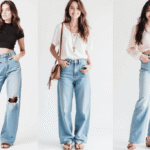Whether you’re working on a graphic novel, animation, fashion design, or concept art, realistic body referencing poses are essential for bringing your characters to life. In 2025, artists are more focused than ever on using accurate body language, expressive gestures, and authentic anatomy to tell powerful visual stories.
This guide dives into how and why to use realistic body references, the best types of poses for various creative fields, and tips for mastering them—whether you’re sketching traditionally or using 3D pose software.
Why Realistic Poses Matter
Artistic Integrity
![Realistic Body Referencing Poses for Creative Projects [2025 Edition] 2 image 75](https://wnais.uno/wp-content/uploads/2025/06/image-75.png)
Realistic poses help ensure that your characters feel believable. The more naturally a figure moves, the more immersive your artwork becomes.
Visual Storytelling
A subtle hand gesture or body shift can speak volumes. Good posing allows your characters to express emotion and drive narrative without dialogue.
![Realistic Body Referencing Poses for Creative Projects [2025 Edition] 3 image 76](https://wnais.uno/wp-content/uploads/2025/06/image-76.png)
Better Anatomy Practice
![Realistic Body Referencing Poses for Creative Projects [2025 Edition] 4 image 77](https://wnais.uno/wp-content/uploads/2025/06/image-77.png)
Accurate poses help train your eye and hand for proportion, perspective, balance, and body mechanics.
Categories of Realistic Poses for Projects
Let’s break down some of the most useful pose types depending on your project needs.
1. Neutral and Natural Standing Poses
These are ideal for character sheets, modeling sheets, or concept lineups.
![Realistic Body Referencing Poses for Creative Projects [2025 Edition] 5 image 78](https://wnais.uno/wp-content/uploads/2025/06/image-78.png)
- T-pose (technical neutral)
- Relaxed stance with arms at sides
- Standing contrapposto (weight on one hip)
- Side profile stance
- Turnarounds (front, side, back)
Best for: 3D modeling, game dev, base character design
2. Action and Dynamic Movement Poses
![Realistic Body Referencing Poses for Creative Projects [2025 Edition] 6 image 79](https://wnais.uno/wp-content/uploads/2025/06/image-79.png)
Captures intensity, athleticism, or drama—perfect for comics, games, and animation.
- Running (mid-stride or launch)
- Leaping or jumping poses
- Swinging a sword or weapon
- Falling or diving through the air
- Combat stances (ready, striking, defending)
Best for: Comics, storyboarding, game concept art
3. Emotive and Expressive Poses
![Realistic Body Referencing Poses for Creative Projects [2025 Edition] 7 image 80](https://wnais.uno/wp-content/uploads/2025/06/image-80.png)
Body language is everything in storytelling—these poses speak louder than words.
- Slumped shoulders, head hanging (sadness)
- Chest out, hands on hips (confidence)
- Arms wrapped around knees (fear or shyness)
- Arms flung up (joy or excitement)
- Fists clenched, wide stance (anger)
Best for: Illustrations, visual novels, emotional scenes
4. Sitting, Reclining, and Resting Poses
![Realistic Body Referencing Poses for Creative Projects [2025 Edition] 8 image 81](https://wnais.uno/wp-content/uploads/2025/06/image-81.png)
Show a character in a moment of pause or relaxation. Mastering gravity and body contact is key.
- Sitting with legs crossed on floor
- Leaning back in a chair, arms folded
- Resting on one arm, side view
- Lying flat on back or stomach
- Knees pulled up to chest while sitting
Best for: Slice-of-life art, cinematic illustrations, fashion poses
5. Interaction and Multi-Figure Poses
![Realistic Body Referencing Poses for Creative Projects [2025 Edition] 9 image 83](https://wnais.uno/wp-content/uploads/2025/06/image-83.png)
These add complexity and realism—useful for scenes with conversation or physical touch.
- Handing something to another person
- Supporting someone who’s injured
- Dancing or hugging
- Argument stance (one pointing, one backing away)
- Carrying a child or pet
Best for: Comics, romance scenes, family storytelling
6. Fashion and Editorial-Inspired Poses
![Realistic Body Referencing Poses for Creative Projects [2025 Edition] 10 image 84](https://wnais.uno/wp-content/uploads/2025/06/image-84.png)
If you’re working in character fashion design or want stylized realism, these are perfect.
- S-curved hips, dramatic arm gestures
- Shoulder-forward, legs crossed at ankle
- Turning over shoulder while walking
- Arms up with elbows bent (editorial style)
- Dramatic weight shifts with lean and twist
Best for: Fashion design, character style guides, high-concept art
Tools to Use for Realistic Body Referencing
In 2025, artists have more tools than ever to generate or find great references.
3D Pose Software
![Realistic Body Referencing Poses for Creative Projects [2025 Edition] 11 image 85](https://wnais.uno/wp-content/uploads/2025/06/image-85.png)
- Magic Poser, DesignDoll, PoseMyArt, Daz 3D
- Rotate models, adjust lighting, and save angles
- Great for custom or difficult angles
Online Pose Libraries
![Realistic Body Referencing Poses for Creative Projects [2025 Edition] 12 image 86](https://wnais.uno/wp-content/uploads/2025/06/image-86.png)
- Line of Action, SketchDaily, Grafit Studio, SenshiStock
- Timed gesture practice or downloadable packs
- Includes different body types and action styles
AI Pose Generators (Use with Care)
![Realistic Body Referencing Poses for Creative Projects [2025 Edition] 13 image 87](https://wnais.uno/wp-content/uploads/2025/06/image-87.png)
- Generative tools like PoseAI or RunwayML
- Can remix body references, though anatomy sometimes needs adjusting
- Double-check foreshortening and proportions
Tips for Practicing With Realistic Poses
- Start with Gesture:
Do 1-2 minute sketches of poses to capture flow and weight before worrying about detail. - Use Reference, Not Copying:
Let the photo or 3D model guide you, but stylize or modify the pose for your character’s anatomy and mood. - Focus on Balance:
Ask yourself: could this figure realistically stand, sit, or move like this? - Try Different Body Types:
Don’t just draw one shape or size. Practice poses with various body proportions to broaden your skill. - Experiment With Angles:
Don’t be afraid to tilt the camera angle. Top-down or low perspective can add depth and realism.
Pose Prompts to Try (Great for Practice)
Here are 10 reference pose prompts to try sketching or photographing:
- Person reaching up to grab something on a shelf
- Mid-fall, arms flailing backward
- Sitting backwards on a chair, arms draped
- Leaning against a wall with one foot up
- Stretching arms overhead with a yawn
- Picking up a heavy box with a bend at the knees
- Twisting to look behind while walking
- Holding a phone to one ear while balancing a bag
- Crouched with one hand on the floor
- Hugging someone while one foot lifts behind
Final Thoughts
In 2025, creating believable, emotionally rich, and anatomically correct poses is more important—and easier—than ever. With a wealth of pose tools, reference libraries, and 3D programs, artists can experiment, learn, and push their creativity further.
Realistic body referencing is not just about drawing better—it’s about understanding how people move, feel, and exist in the worlds you create. So whether you’re telling a story with a single image or building a whole universe, mastering the body in motion gives your work strength and soul.

![Realistic Body Referencing Poses for Creative Projects [2025 Edition] 1 Realistic Body Referencing Poses for Creative Projects [2025 Edition]](https://wnais.uno/wp-content/uploads/2025/06/Pose-References-for-Artists-Art-Side-of-Life.webp)

